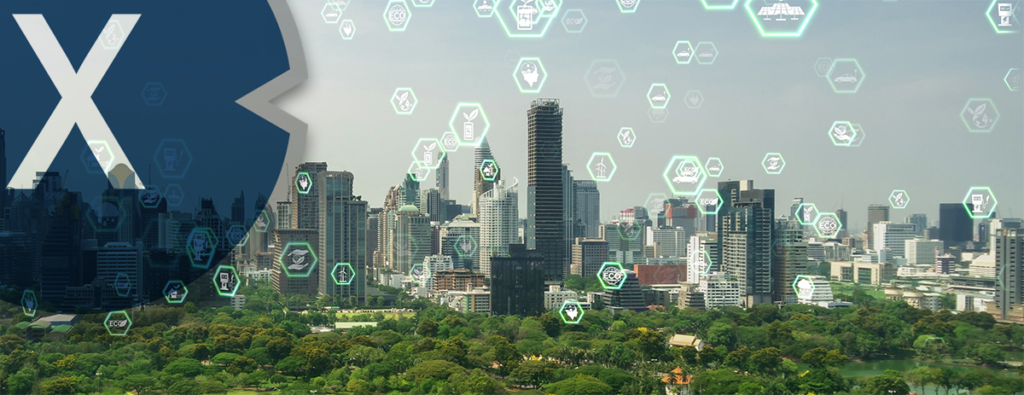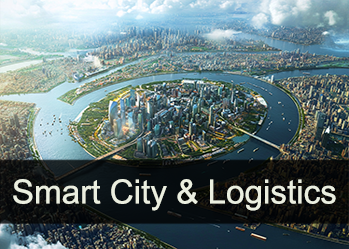Energetic urbanization: climate analyses, the master plan for 100% climate protection and the climate emergency declarations of cities and municipalities
Language selection 📢
Published on: August 1, 2023 / update from: August 4, 2023 - Author: Konrad Wolfenstein
➡️ Here is the English version 😊

Energetic urbanization: climate analyzes and the master plan for 100% climate protection - Image: Xpert.Digital
Energetic urbanization and its meaning
➡️ The “Smart Columbarium” – the innovative solution that is still completely unknown in Europe and more
➡️ “Master plan 100 % climate protection” using the example of the cities of Kiel, Münster and Heidelberg
Energetic urbanization refers to the process of making cities and communities more energetically efficient and sustainable. In view of advancing climate change and increasing global challenges related to energy consumption, energy urbanization is of great importance. Cities are responsible for a significant share of global emissions, but they also offer enormous potential to combat climate change and accelerate the transition to a low-carbon society.
Energy urbanization aims to reduce energy consumption and greenhouse gas emissions in cities by relying on renewable energy, energy efficiency, green infrastructure and sustainable mobility. Social and economic aspects are also taken into account in order to create a livable and resource-saving environment for the residents.
Climate analyzes for cities and municipalities
Climate analyzes play a crucial role in the development and implementation of measures in the context of energy urbanization. Such analyzes provide important information about the current climate in a city or municipality, identify climate-related risks and help identify potential measures to adapt to climate change. They are an important tool for understanding the interactions between urban development and climate and developing appropriate strategies.
Climate analyzes can cover various aspects such as temperature and precipitation patterns, air quality, extreme weather events and vulnerability to climate-related risks. Using this data, cities and municipalities can be better prepared for climate-related challenges and make long-term planning that promotes climate protection and city resilience.
Suitable for:
Synergies between energetic urbanization and climate protection
Energetic urbanization and climate protection go hand in hand and offer numerous synergies. Sustainable and climate-friendly urban development can not only help reduce greenhouse gas emissions, but also improve people's quality of life. For example, promoting public transport and cycling not only leads to fewer emissions, but also to less traffic congestion and a higher quality of life through cleaner air and less noise.
The energy-efficient renovation of buildings not only contributes to reducing emissions, but can also reduce energy costs for residents and improve living comfort. Green spaces and urban gardens not only contribute to climate adaptation by reducing heat islands, but also offer recreational and adventure spaces for the population.
Energy urbanization and the 100% climate protection master plan for cities and municipalities represent a promising opportunity to actively combat climate change, improve the quality of life in urban areas and shape a sustainable future for future generations.
The master plan 100% climate protection for cities and municipalities
The 100% Climate Protection Master Plan is a program of the Federal Ministry for the Environment, Nature Conservation and Nuclear Safety (BMU) that aims to reduce greenhouse gas emissions in Germany by 80 to 95 percent compared to 1990 levels by 2050. In the context of energetic urbanization, the master plan plays a central role for cities and municipalities.
The 100% Climate Protection Master Plan offers cities and municipalities a clear strategy and a framework for action to decarbonize their energy supply and achieve their climate goals. The implementation of the master plan requires a wide range of measures, ranging from promoting renewable energies to increasing energy efficiency and promoting sustainable mobility.
Various support measures and funding programs are available for cities and municipalities that participate in the master plan. This includes financial support for the preparation of climate analyzes and the development of action plans. The exchange of best practice examples and experiences between the participating cities also plays an important role in learning from each other and disseminating successful approaches.
Suitable for:
Interesting solutions that we at Xpert offer cities, communities, municipalities and companies
➡️ City solar carport modules for photovoltaic parking spaces with translucent solar modules
➡️ City Pergolas, the ideal concept for the green smart city of the future
The "Smart Columbarium" as an innovative solution for space saving and urban development
A novel and exciting solution is the “Smart Columbarium”. This concept offers the possibility of saving up to 90% of the cemetery area and using the freed-up green space for other uses. This energetic and space-optimized burial site was developed by logisticians from Japan and Germany. The “Smart Columbarium” is an innovative way of burial where urns are stored in a space-saving and technologically advanced manner. This reduces the space required for traditional graves and frees up valuable green space. These areas can then be used as a valuable contribution to improving the living environment and quality of life of residents.
The combination of protecting and promoting existing green spaces, careful inner-city densification and innovative concepts such as the “Smart Columbarium” could help cities and municipalities find a balance between urban development and environmental protection. By specifically relying on green infrastructure and developing new ways of using land, the city can preserve the positive bioclimatic conditions in residential areas and at the same time improve the climate in heavily built-up regions.
Learn from the Japanese: 91% of the population already lives in urbanized areas
More about it here:
The Smart Park or Smart Columbarium concept
The Smart Columbarium concept describes the possibility of reducing the space required for cemeteries by an impressive 90%. This innovative solution creates valuable space that can be used to create green leisure and recreation parks. This measure aims to increase the culture of well-being in the community and to provide residents with an attractive environment for their leisure activities.
More about it here:
- Smart Park: New green parks thanks to Smart Columbarium
Access code / password : daifuku
Municipalities in Germany that have declared a climate emergency
Climate change is one of the most pressing challenges of our time. More and more cities and municipalities in Germany are recognizing the importance of climate protection and have declared a climate emergency. In this article we introduce you to some of the German cities that have joined this important step.
Konstanz – The pioneer in May 2019
The city of Konstanz was the first municipality in Germany to declare a climate emergency in May 2019. In doing so, she sent a strong signal and put climate protection at the top of her agenda. Since then, Konstanz has inspired many other cities to follow this example.
Marl, Horstmar, Saarbrücken and other cities join in
After Konstanz declared a climate emergency, many other cities and municipalities in Germany followed suit. They committed to prioritizing climate-friendly solutions in their decision-making processes. The cities that have declared a climate emergency include Marl, Horstmar, Saarbrücken, Herne, Neumünster, Wiesbaden, Fehmarn, Marburg, Mainz, Koblenz and Munich.
Continuing growth in climate emergency declarations
In 2019, several cities and regions in Germany declared a climate emergency. This trend continued in the following years, and more municipalities joined in 2020 and 2022. It is gratifying to see how more and more people and communities are recognizing the urgency of climate protection and taking active action.
Climate protection is a priority
The climate emergency is an important tool in the fight against climate change. With their courageous step, cities like Konstanz have shown that they are ready to make climate protection a priority. Other municipalities followed this example and declared a climate emergency. This is a glimmer of hope for the future and shows that climate protection is becoming increasingly important in Germany.
List of German places and communities that have declared a climate emergency
More about it here:
Recognition of the climate emergency in the Bundestag was rejected, but still significant
On June 28, 2019, there was a pioneering vote in the Bundestag, in which the “recognition of the climate emergency” was decided. The importance of this coordination for climate protection and the implementation of the goals of the Paris climate agreement should not be underestimated.
Prioritizing climate protection in political decisions
The supporters of the motion emphasized the urgent need to prioritize climate protection in political decisions. Given the increasing threat of climate change, measures must be taken to reduce emissions and limit global warming. Only by consistently taking climate protection into account in all political decision-making processes can we maintain the chance of containing the catastrophic effects of climate change.
Achieving the climate goals of the Paris Climate Agreement
The 2015 Paris Climate Agreement aims to limit global warming to well below 2 degrees Celsius, ideally to 1.5 degrees Celsius. To achieve this ambitious goal, all countries must take concrete measures to reduce their CO2 emissions. Recognizing the climate emergency is an important step in raising awareness of the urgency of action and strengthening the political will for effective climate action.
Need for a comprehensive climate protection law
As an immediate measure to deal with the climate crisis, the roll-call vote called for the adoption of a comprehensive climate protection law. Such a law would set clear guidelines and obligations on how to achieve climate goals. It would define the framework for expanding renewable energy, promoting energy-efficient technologies and switching to climate-friendly means of transport. Such a climate protection law would be a milestone on the way to a climate-neutral society.
Support from different political camps
The roll-call vote showed an interesting dynamic within the Bundestag. The Green and Left factions voted unanimously in favor of the motion, thereby underlining their clear stance on climate protection. Surprisingly, individual members of the FDP also agreed to the motion, as did the non-attached member Marco Bülow. This makes it clear that the issue of climate protection is also gaining importance in other political camps and is perceived as a central concern of society.
Rejection by the CDU/CSU, SPD and AfD
While there were positive signals from some political groups, the CDU/CSU, SPD and AfD factions voted unanimously against recognizing the climate emergency. The reasons for this negative attitude are diverse and reflect different political beliefs. Nevertheless, the rejection also shows that there are still obstacles and resistance when it comes to putting climate protection on the political agenda.
A milestone for climate protection in Germany
The vote on the “recognition of the climate emergency” in the Bundestag was an important event for climate protection in Germany. It illustrated the growing importance of climate protection in the political debate and made a strong signal for the urgent need to take concrete measures to protect our planet. The support from various political camps shows that climate protection is increasingly perceived as a common challenge that requires common solutions. Despite the negative attitude of some parties, the recognition of the climate emergency is an important step on the way to a climate -neutral and sustainable future in Germany.
Suitable for:
Challenges in focus: climate protection, urbanization and supply gaps
In addition to climate protection, there are other challenges such as population growth (urbanization) and solving impending supply gaps with last mile logistics, micro-hubs, etc
Climate protection is undoubtedly one of the most important challenges of our time. Rising greenhouse gas emissions are a major contributor to climate change and require urgent action to limit global warming and minimize the impact on the environment. Through the Paris Agreement, the international community has committed to limiting global warming to well below 2 degrees Celsius. This requires a radical transformation of our energy and mobility system towards a low-carbon future.
Population growth and urbanization
Population growth and the associated urbanization represent another significant challenge. The global population is growing rapidly and more and more people are moving to cities to find better living conditions. The United Nations estimates that by 2050, around 68 percent of the world's population will live in urban areas. This trend has enormous social, economic and environmental impacts.
Urbanization can bring both opportunities and challenges. On the one hand, it offers the opportunity to develop more efficient infrastructure and services that improve the quality of life of city residents. On the other hand, the increasing demand for energy, living space and mobility leads to increased resource consumption and a higher ecological footprint.
Impending supply gaps and possible solutions
In addition to the challenges mentioned, many cities also face the risk of supply gaps. Especially in urban areas in which there is a high population density, the supply of energy, water, food and other important resources can be problematic. This phenomenon is often referred to as the “Last Mile Problem”, in which the efficient distribution and provision of goods and services in urban areas is a logistical challenge.
In order to close these supply gaps and at the same time promote climate protection, innovative solutions are required. “Micro hubs” play an important role here. Micro hubs are small, decentralized distribution centers that enable efficient and environmentally friendly care for urban areas. They act as an interface between larger distribution centers and the last miles of the supply chain in the city.
Suitable for:
Smart technologies and sustainable mobility
Addressing the challenges related to climate protection, urbanization and supply gaps requires the use of smart technologies and sustainable mobility. Cities can become smarter and use resources more efficiently through the use of digitalization and networking.
Sustainable mobility is another important aspect. Electromobility, cycling infrastructure, car sharing and public transport systems can help to decarbonise the transport sector and improve air quality in cities.
Integration of renewable energy and energy storage
In order to advance climate protection and ensure security of supply, the integration of renewable energies is of central importance. Cities must increasingly convert their energy supplies to renewable sources such as solar energy, wind power and geothermal energy. This requires investment in renewable energy technologies and intelligent integration into the electricity grid.
In addition, energy storage is an essential part of a sustainable energy supply. Storage technologies, such as batteries or power-to-gas systems, make it possible to store excess energy and access it again when needed. This helps to balance fluctuations in energy production from renewable sources and ensure a stable supply.
Research and innovation as the key to success
Overcoming the challenges mentioned requires strong cooperation between science, business and politics. Research and innovation play a crucial role in developing new technologies and concepts that meet the requirements of sustainable and future-proof urbanization.
Governments and cities should create incentives to promote research and development in the areas of climate protection, energy efficiency and sustainable mobility. Through targeted funding programs and investments in innovative start-ups and companies, new approaches can be promoted and the path to climate-friendly and livable urban design can be paved.
Climate Analysis: A Comprehensive Look at the Climate
Introduction to climate analysis
Climate analysis is an important scientific method for studying the climate in specific regions or globally. It includes different techniques and approaches to collect and analyze data that is crucial to understanding climate.
Climate study: research and findings
A climate study involves the in-depth study of climate patterns, weather events, and climate changes over a period of time. Scientists use various data sources to identify and interpret long-term trends and short-term fluctuations.
Climate data analysis: evaluation of historical records
Climate data analysis focuses on evaluating historical climate records such as temperature data, precipitation and humidity. By using modern statistical methods, patterns and trends in the data can be identified, providing important information for assessing the current climate.
Climate investigation: research into specific phenomena
In climate studies, the focus is on researching specific climatic phenomena such as El Niño, La Niña or climate cycles. The aim is to better understand the underlying causes and effects of these phenomena and to develop possible predictive models.
Climate assessment: Assessment of climatic conditions
Climate assessment involves a comprehensive assessment of the climatic conditions in a specific area. Various factors such as temperature, precipitation, air quality and solar radiation are taken into account. The results serve as a basis for climate-related decisions and measures.
Climatic analysis: Study of climate zones and regions
Climatic analysis involves the study of climate zones and regions around the world. By identifying similar climatic features in specific areas, comparisons can be made to identify similarities and differences between different regions.
Climate observation: monitoring current climate changes
Climate observation involves the continuous monitoring of current climate changes in real time. Weather stations, satellites and other technologies are used to collect and analyze data on temperature, precipitation and other relevant parameters.
Climate data evaluation: Use of big data and technology
Modern technology and big data analysis are used to evaluate climate data. Large amounts of climate data are collected to identify patterns and trends, helping to better understand the climate and make more informed climate-related decisions.
Climate recording: data collection for forecast models
Climate sensing focuses on data collection for the development of forecast models. Climate scientists continually collect data to build models that predict future climate changes and weather events.
Climate diagnosis: analysis of the causes of climate events
Climate diagnostics deals with analyzing and researching the causes of climate events such as heat waves, droughts or heavy rain. By understanding the underlying factors, preventive measures can be taken to mitigate potential impacts.
➡️ This comprehensive presentation of the various aspects of climate analysis highlights the importance of this research discipline for understanding and dealing with the challenges of climate change. From evaluating historical data to developing forecast models, climate analysis plays a central role in the effort to better understand our climate and find sustainable solutions for the future.
Summary: Energetic urbanization
🏙️ Energetic urbanization and its importance:
- Process to make cities more energetically efficient and sustainable.
- Cities contribute to a significant proportion of global emissions and offer potential to combat climate change.
- Goals: Reducing energy consumption and greenhouse gas emissions, promoting renewable energies, energy efficiency, green infrastructure and sustainable mobility.
🌡️ Climate analyzes for cities and municipalities:
- Crucial role in the development of measures within the framework of energy urbanization.
- Provide important information about the climate, identify climate-related risks and help adapt to climate change.
- Include aspects such as temperature, precipitation patterns, air quality, extreme weather events and vulnerability.
🤝 Synergies between energetic urbanization and climate protection:
- Sustainable and climate-friendly urban development leads to a reduction in emissions and an improvement in the quality of life.
- Promoting local public transport and cycling reduces emissions and traffic congestion.
- Energy-efficient renovation of buildings reduces energy costs and improves living comfort.
- Green spaces and urban gardens contribute to climate adaptation and recovery.
🌍 Master plan 100% climate protection for cities and municipalities:
- The goal is to reduce greenhouse gas emissions in Germany by 80 to 95 percent by 2050.
- Offers a clear strategy and framework for action for decarbonized energy supply and climate goals.
- Contains measures to promote renewable energy, energy efficiency and sustainable mobility.
- Cities and municipalities receive support with climate analyzes and exchange of experiences.
🏢 Interesting solutions for cities and municipalities:
- Building-integrated photovoltaics for aesthetics and reduction of urban or urban heat islands.
- City solar carport modules for photovoltaic parking spaces with translucent solar modules.
- City pergolas as a concept for green smart cities.
- Smart Columbarium for space savings and green inner cities.
💡 The “Smart Columbarium” as an innovative solution for urban planning:
- Concept enables up to 90% savings in cemetery space.
- Urns are stored in a space-saving and technologically advanced manner.
- Freed-up green spaces improve the living environment and quality of life.
- A combination of green space protection, inner-city densification and smart columbarium can promote environmentally friendly urban development.
#️⃣ Hashtags: #EnergeticUrbanization #Climate Protection #Masterplan100 #SmartCity #Greenspaces
Xpert.Plus Smart City & City Logistics Consulting with Konrad Wolfenstein
Xpert.Plus is a project from Xpert.Digital. We have many years of experience in supporting and advising on storage solutions and in warehouse optimization , which we bundle in a large network Xpert.Plus
I would be happy to serve as your personal advisor.
You can contact me by filling out the contact form below or simply call me on +49 89 89 674 804 (Munich) .
I'm looking forward to our joint project.
Xpert.Digital – Konrad Wolfenstein
Xpert.Digital is a hub for industry with a focus on digitalization, mechanical engineering, logistics/intralogistics and photovoltaics.
With our 360° business development solution, we support well-known companies from new business to after sales.
Market intelligence, smarketing, marketing automation, content development, PR, mail campaigns, personalized social media and lead nurturing are part of our digital tools.
You can find out more at: www.xpert.digital – www.xpert.solar – www.xpert.plus




























